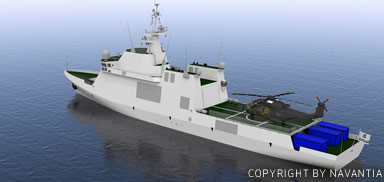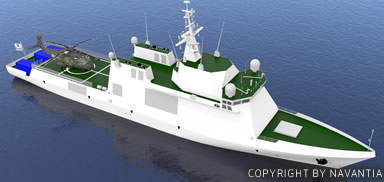Modelling Plans for 2025 and 2050 scenarios will consider the following technologies:
- Implementation of hybrid propulsion solutions that could be more efficient along the OPV operational cycle, (improving of diesel engines efficiency, or PTI/PTO options)
- High density electrical machines such as permanent magnet motor or high temperature superconductive machines
- Electric storage: batteries, flywheels and supercapacitors
- Energy distribution by means of a DC grid and power system
- Shore “Plug – in” systems
- Energy recovery technology like Waste Heat Recovery Systems
- Alternative fuels for diesel or dual fuel engines as LNG or biofuels
- Renewable energies (wind, solar)
- Reducing the emissions from diesel engines (internal and external technologies)
- Reducing hotel load: reducing electrical demand of lighting, HVAC systems, pumps, etc…
- Propeller new concepts like pump jets or CPP counter rotating pod propellers
- Optimizing hydrodynamic performance and improving Energy Management Systems, taking advantage of the Hydrodynamic Model of the vessel
The final selection of any of these proposals will be affected by technical maturity level of each of them. The short and medium term technologies could be applied in 2025 design concept, and medium and long term in 2050 OPV.

2025 Ship Concept
In 2025 design, the main progress beyond state of the art will be to develop cost effective hybrid propulsion and electric generation plants that will incorporate previous candidate efficiency and emission reduction technical enhancements, selected taken into account the expected maturity of different technologies along the next years, and in order to ensure the viability of the proposal, they should be nowadays sufficiently developed.

2050 Ship Concept
The 2050 design will include the enhancements applied to the 2025 design, and additional energy efficiency measures, which presumably will be available in 2050 such as improved versions of electric storage systems, electric motors with higher power density, reduce size fuel cells, and renewable energies. The main idea will be to implement a full electric propulsion system removing diesel engines as main generators, to be replaced by alternative clean energy sources as fuel cells or renewable energies.
The expected challenges that are expected by the study of the new power and propulsion systems are:
- To reduce polluting emissions (CO2, NOX, and SOX)
- To increase fuel efficiency
- Flexibility to fully accomplish various missions
- Low maintenance costs
- Reduced weight and volume to ease installation on moderate size vessels
A preliminary analysis of OPV Application Case shows that the implementation of efficiency measures to the baseline hybrid propulsion system suited to its operating profile, could lead to important savings in energy consumption and reduction of emissions of around 20%, in a medium term 2025 OPV concept. These technical measures consist mainly of improving the efficiency of the hybrid propulsion system and reducing the electrical demand of the consumers.
The principal goal in 2050 design concept will be the using of alternative energy sources in all electric propulsion system in which emissions will be reduce as much as possible with an aim of at least 40%. However, in 2050 design, it is difficult to know whether the technology that will be actually available, may be applied in this type of vessel, in which both the size and weight are critical issues.


